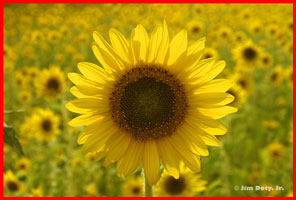|
Sunflowers usually look best when photographed in sunlight, especially when backlit (many other kinds of flowers look best in the soft light of a hazy day).I
found this field of sunflowers in northwest Michigan. I had spotted them a day earlier, but lighting conditions were just not right. A day later, they were backlit by the late afternoon sun - just what I wanted. You can
see how some petals cast shadows on others. The central flower in this photo was taller than most of the others and close to the front of the field so I could isolate it from the others. I used an aperture of f/9.5
which was sufficient to give me enough sharpness on the central flower but render the background flowers softly out of focus. I tried different apertures for different different depth of field
renditions, but I liked this version best. Manual exposure compensation on the petals was about +1 stop (plus one) to render the petals lighter than medium tone (see the article on Exposure for more information on exposing for tonality).The 28-135mm lens
was set to 53mm, an equivalent in 35mm film terms to 85mm, a nice focal length for portrait work. In this case, a sunflower portrait. If I had not used fill-flash, the central part of the sunflower, which was
not lit by the sun, would have been rendered a featureless black. I wanted the pattern of the seeds to show, so I popped up the built in flash. I did not want the flash to be obvious, so I dialed in a flash
compensation of -1 stop (minus one). This gave me just the affect that I wanted. Straight flash would have been too obvious. The camera and lens were mounted on a tripod as an aid to more accurate compensation
and to make longer shutter speeds possible when I used smaller apertures. The IS (image stabilization) feature on the lens was turned off.
September 16, 2003
|




